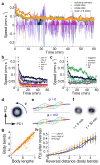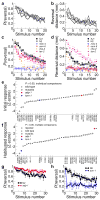High-throughput behavioral analysis in C. elegans
- PMID: 21642964
- PMCID: PMC3128206
- DOI: 10.1038/nmeth.1625
High-throughput behavioral analysis in C. elegans
Abstract
We designed a real-time computer vision system, the Multi-Worm Tracker (MWT), which can simultaneously quantify the behavior of dozens of Caenorhabditis elegans on a Petri plate at video rates. We examined three traditional behavioral paradigms using this system: spontaneous movement on food, where the behavior changes over tens of minutes; chemotaxis, where turning events must be detected accurately to determine strategy; and habituation of response to tap, where the response is stochastic and changes over time. In each case, manual analysis or automated single-worm tracking would be tedious and time-consuming, but the MWT system allowed rapid quantification of behavior with minimal human effort. Thus, this system will enable large-scale forward and reverse genetic screens for complex behaviors.
Conflict of interest statement
The authors declare no competing financial interests.
Figures




References
-
- Baek JH, Cosman P, Feng Z, Silver J, Schafer WR. Using machine vision to analyze and classify Caenorhabditis elegans behavioral phenotypes quantitatively. J Neurosci Methods. 2002;118:9–21. - PubMed
-
- Cronin CJ, Feng Z, Schafer WR. Automated imaging of C. elegans behavior. Methods Mol Biol. 2006;351:241–251. - PubMed
-
- Tsechpenakis G, Bianchi L, Metaxas D, Driscoll M. A novel computational approach for simultaneous tracking and feature extraction of C. elegans populations in fluid environments. IEEE Trans Biomed Eng. 2008;55:1539–1549. - PubMed
Publication types
MeSH terms
Grants and funding
LinkOut - more resources
Full Text Sources
Other Literature Sources
Miscellaneous

